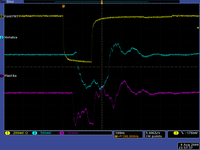TF NEUP 2011
Technical Work Scope Identifier: FC-5
Project Summary
We propose to develop a gaseous detector sensitive to fast (100 keV - 100 MeV) neutrons to monitor the neutron flux in nuclear reactors. The monitoring of a reactor core's neutron flux has been a long standing problem due to the high neutron and gamma intensity. Gaseous detector technology from recent developments in high energy physics will be used to improve a fission chambers ability to operate in a high neutron flux environment. The technology in question will decrease an ionization chambers response time by at least a factor of 3. The faster detector signal will result in less dead time and increase the neutron flux rate that will cause detector signal pile up.
Importance and relevance of proposed work
Logical pathway to work accomplishments
Deliverables and outcomes
Timeline
Budget
Neutron fluxes in reactors
according to http://www.bnl.gov/bnlweb/history/HFBR_main.asp
a 40 MW reactor at Brookhaven's High Flux Beam Reactor (HBFR) produced a neutron flux of for experiments. The neutron flux was a maximum outside the core because the neutrons were directed tangentially to the core instead of radially.
1e11 to 1e12 neutrons per cm^2 per second may be more typical
Let's assume this flux is an upper limit for a detector to measure neutron fluxes in a reactor core. The pulse width of a regular GEM detector is sec. Because of the high gain a signal may be observed over a surface area of 3 cm^2 (10 cm by 300 \times 10^{-3} cm ). A GEM detector with this active area would only be able to count neutron fluxes of if the detector efficiency was 100 %. A detector efficiency of 10^{-5} would be able to see rates of 10^{11}.
The pulse width of a standard ionization chamber is on the order of 300 nsec, so a standard GEm detector would only be able to have a factor of 6 higher rate than a typical ionization/fission chamber.
Path to work accomplishments
The first year of effort will focus on the production of pre-amplifiers for ionization chamber. A fissionable material will be added to the ionization chamber in year two followed measurements of the chamber's neutron detection efficiency.
Deliverables and outcomes
1.) Neutron sensitive ionization chamber (no position readout)
Time Frame
Budget
| IAC | Task |
Each year
1 grad students ($50k)
2 faculty summer months ($20k)
Beam time: electron experiment which produces isotropic neutrons. Compare neutron rates seen by several know detectors to the rate from the THGEM based detector.
Bibliography
- File:NEUP Pre-app RFP.pdf
- "Fission chambers for CANDU SDS neutronic trip applications", V. Mohindrs, M. Vartolomei, and A. McDonald, 28th Annual Canadian Nuclear Society (CNS) conference, June 3-6, 2007New Brunswick, Canada Media:Virender_CANDU2007.pdf
- GE builds nuclear reactor instruementation http://www.ge-mcs.com/en/nuclear-reactor-instrumentation/
